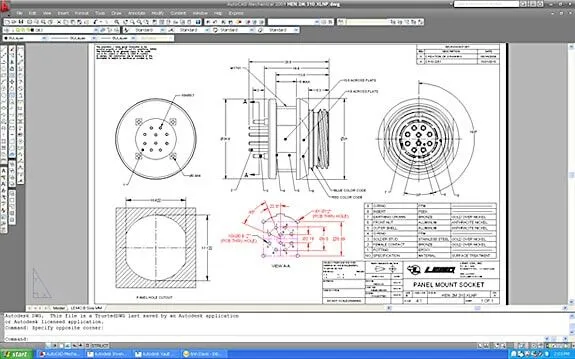Large Format Scanning | Small Format Scanning | Large and Small Scanning
CAD / CAM Services, Inc. uses the latest in large format scanners. These allow the scanning of up to 56″ wide media, with 54″ wide image width. We can scan up to 2,400 dpi and support both 256 grayscale (often used in Aerial Photography), and 42-bit high-speed color, with a thickness of up to .5″.Our scanners directly support most any raster file format. Including all flavors of *.tiff, *.jpg, *.PDF, and most others.
Typically the CAD files we provide include: AutoCAD .DWG, Intergraph .DGN, ERSI’s ArcInfo .001 coverage files. Raster scans might include .TIF (any flavor), CALS .GP4, .BMP, .PCX, and .JPEG for color and gray scale.
Small Format ScannerCAD / CAM Services, Inc. uses Scan-Optics for our small format scanning. These $200,000 scanners are the largest, fastest, most accurate scanners on the market today. They provide the speed and turnaround our client’s demand, with the highest image quality possible.
The most common raster files are compressed *.tiff group 4. Proper indexing is always our largest concern for this type of scanning. We have extensive experience with Interactive Electronic Technical Manuals (IETM) and other such complex file systems and formats.
VRS – In 1998 Kofax introduced one of the industries’ best image enhancement tools we have seen to date. VRS technically scans an image in grayscale and automatically processes this for its image quality. VRS is smart enough to strip out dark and color backgrounds and still leave the text intact, producing a standard bitonal *.tiff gp4 image. You will only see this significant technology in the ‘better’ production scanners today. All of our paper scanners now support this technique.
The most common raster files are compressed *.Tiff group 4. Proper indexing is always our largest concern for this type of scanning.
Microfiche & MicrofilmMekal produces some of the finest film scanners available. We use these and they support 16 mm, 35 mm, and microfiche. They support 200 or 400 dpi and both black/white and grayscale.
Aperture CardsWe use both the high-end Photo Matrix and Ideal/Contex aperture card scanners. These support 100-400 dpi scanning in both black/white and grayscale. We scan in excess of 250,000 cards per year.
Scanning ServicesCAD / CAM SERVICES comes from a different perspective than most scanning firms. Because so much of our business involves CAD Conversion, we have to be able to see the images at their maximum potential. If we can’t see the image, we can’t convert it. Simply put, this is why we are forced to buy the best scanners on the market today. We simply can’t afford anything less than perfect image quality for our scanning and conversion clients.
It is not uncommon in our large format scanning to scan the same large format engineering drawing 4-8 times!
On bulk film scanning projects we work with you to determine how much Q/C is needed. Do you wish us to individually Q/C each and every image – or maybe every 3-5 images would be sufficient?
Some comments on Bitonal -vs- Gray ScaleThis can be a tough question. Samples are the only way to truly answer this. Here are some factors to consider: 1) How good is good? 2) Grayscale will almost always look more like the original image. 3) Your human eye sees in color and Gray Scale, and your eye is better suited to ‘take out’ unneeded information. 4) Not all high-speed scanners can scan grayscale. 5) Grayscale scanning is 2-3 times slower to scan, and therefore more expensive. 6) The image size for Grayscale is 2-3x larger.
How do we scan for our own work? Generally, for full-size engineering drawings for raster-to-vector (also known as r 2 v, r to v, r2v) work we almost exclusively use Grayscale scanning at 300 dpi. Each project often uses different techniques and software conversion products and methodology for each document type. That is why we use software from Consistent Software (Wise Image), GTX (RasterCAD), Softelec (VP Studio), Hitachi (Tracer) and our own custom written and developed software. I.e.: Large format and aperture cards are often used in R/V projects, where the film is often used only for archival.
Image prepThis is often a very misunderstood concept. Somebody – whether it be your company or our firm – will need to often ‘prep’ your documents to get them ready to scan. For example, somebody will need to remove staples, unfold any sheets, possibly reorder them, and many other conditions. Think of it this way, when scanning small format paper, somebody must prepare the documents just as if you were going to run them through your document feeder at your copy machine. Which leads us to our next step indexing.
IndexingHow are you going to find the images after they are scanned? Maybe in engineering drawings, the drawing number in the title block is sufficient? Don’t skimp here. Pay a little more upfront and get them ‘over indexed’. Why does a person put all that information in a title block? Why are drawings stored separate folders? It is there for a reason.
CAD / CAM Services can even go into each image and manually pull out any piece of information required. This data is often delivered in some type of database (often Microsoft Access) and imported directly into a document management system.
Document DestructionYour secure documents can be professionally destroyed with our production shredding equipment. All documents are cross shredded to ensure complete destruction. We use the Federal Governments method for complete and secure document destruction.
Scanned images can be delivered via FTP, CD, 8 mm tape, and Zip drives.
Recent Posts


The Key To Be Within Regulations And Ahead On The Racetrack
Whether to improve the car’s aerodynamics or make the driver’s experience more comfortable in the cockpit, WTRAndretti’s engineers have decided to trust and rely on Creaform’s expertise and technology.

CAD Outsourcing Doesn’t Have to Be Done In India
CAD Outsourcing Doesn’t Have to Be Done in India Do a Google search for “CAD Outsourcing” and what you’ll find is lots of firms located in India, which is fine if you’re prepared to go off-shore for CAD services. But what if your U.S. based company prefers to stay a...

AutoCAD Fiber Optic Designs & Drawings
Before proceeding forward in explaining the affinity between AutoCAD and Fiber Optic, it would be prudent to rationalize the utility of optical cables. When communicating between systems, either via the internet or via an internal network system, a medium needs to be...
